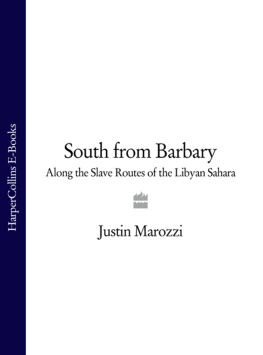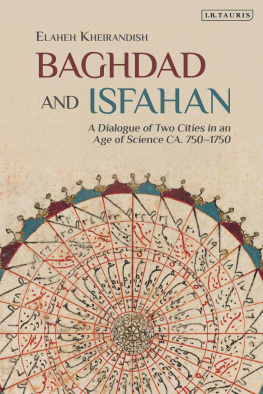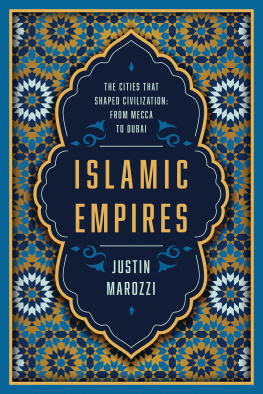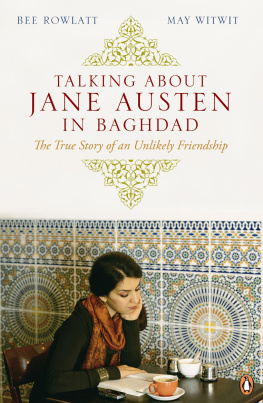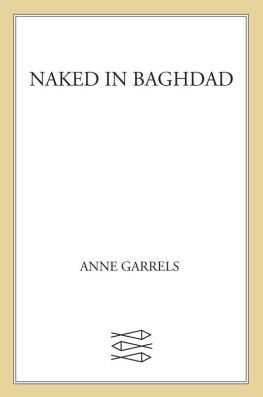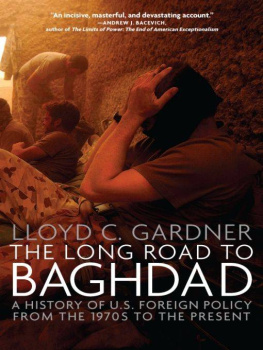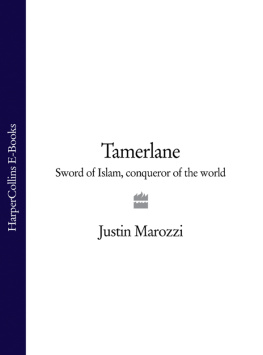ABOUT THE AUTHOR
Justin Marozzi is a Councillor of the Royal Geographic Society and a Senior Research Fellow at Buckingham University. He has broadcast for BBC Radio Four, and regularly contributes to a wide range of publications, including the Financial Times, for which he has worked in Iraq, Afghanistan and Darfur. His previous books include the bestselling Tamerlane: Sword of Islam, a Sunday Telegraph Book of the Year (2004), and The Man Who Invented History: Travels with Herodotus.
PENGUIN BOOKS
BAGHDAD
A tremendous narrative history His book is a great achievement: brave (he has lived in the Iraqi capital for ten years), densely researched, authoritative, vivid and, it should be said, not for those who like a happy ending The history of the city of peace, as Marozzi concludes, seems so often to have been written in blood; yet Baghdad still has pride, and, above all, endurance. Perhaps, one day, peace will come again Christopher Hart, Sunday Times
An epic history Mr Marozzi plunges into the modern city, dangers and all, to visit tombs and charnel grounds and to interview current residents, including Ahmed Chalabi, the man who egged the Americans on to invade in 2003 and then turned on them with a guile that would have been familiar to his forebears Economist
An all too timely history of the city An astonishing story, brilliantly told David Sexton, Evening Standard
Justin Marozzis superb history of Baghdad is fully alive to the nuances of his story. Marozzi is a fine travel writer who has also written a biography of the Mongol tyrant Tamerlane. Here he interweaves testimony from Baghdadis and written sources to create a gripping account Sameer Rahim, Daily Telegraph
An epic biography Marozzi proves to be a generous and skilled navigator as he leads us through Baghdads 1,300-year history it is like being taken around a museum by a wise and amusing guide Anthony Lloyd, The Times
Fascinating an enthralling journey into a past of learned scholars, towering mosques and extravagant banquets Dominic Sandbrook, Sunday Times
A rare book, an exceptional masterpiece Ayad al-Zamili, Kitabat
There is much hope to be found in Marozzis sympathetic and thoughtful account in pages that vividly capture centuries of heartbreak Baghdad offers a much-needed sense of perspective Nadia Atia, The Times Literary Supplement
Iraq probably doesnt feature in most of our travel plans for the foreseeable future, Baghdad is an admirable substitute for a visit to that city pungent history, infused with the writers own experiences of the place Martin Gayford, Spectator
As Marozzi shows in his fascinating and intelligent study of the city, Baghdads position at the cross-roads of the world proved to be a highly dangerous location Patrick Cockburn, Independent
A richly researched chronicle of a city that was once the learned capital of the world, but whose dizzying apex gave way to a long and miserably bloody decline Baghdads history is not a happy one, but it is fabulous and ghastly and fascinating Wendell Steavenson, Prospect
This account of Baghdad reaches another level as the story gets closer to our own time intense and fascinating. The description of the assassination of the Iraqi monarchy in 1958 is convincing, and vivid, as are details of the reign of terror that Saddam inflicted on his country Arriving at the end of this long story of sublime beauty and unimaginable horror, of generosity and greed, of grandeur and pettiness, peace and blood, the events of the past couple of decades since Saddams invasion of Kuwait seem all the more comprehensible Anthony Sattin, Observer
The history of Baghdad more than any other city mirrors the ebb and flow that has marked Arab history and civilisation. Justin Marozzis book is a brilliant, evocative and erudite retelling of the history of this most intriguing of cities He knows whereof he speaks, having trudged the streets and visited the monuments and landmarks even where they have been reduced to rubble a work of love, and a homage to a place that has somehow survived the depredations of its conquerors, the fractiousness of its population and the duplicity of its rulers Ali A Allawi, Spectator
A lively, accessible romp through 1,400 years of Baghdads history Marozzi has a journalists eye for a good anecdote Eleanor Robson, History Today
An impassioned plea on behalf of whatever vestiges of humanity and culture still exist in the beleaguered and strife-torn Iraqi capital impressive testimony to the enduring strength of British travel writing Michael Burleigh, Evening Standard, Books of the Year
To my dear friend Manaf al Damluji
The story of the City of Peace is largely the story of continuous war; where there is not war, there is pestilence, famine and civil disturbance.
Richard Coke, Baghdad: The City of Peace, 1927
List of Illustrations
INTEGRATED ILLUSTRATIONS
. Reconstruction of Baghdads gates and city walls by the German archaeologist Ernst Herzfeld, reprinted from Jacob Lassner, The Topography of Baghdad in the Early Middle Ages, p. 210.
. Julnar of the Sea, frontispiece illustration by David Coster from Antoine Galland, Les mille et une nuits: contes arabes, Vol. 7, 170714. (Reproduced by permission of the Master and Fellows of Trinity College Cambridge (G.24.52))
. The British flag over Bagdad, from War Illustrated, 24 March 1917.
COLOUR PLATES
Page from a Quran by calligrapher Ibn al-Bawwab, Baghdad, c. 1000. (Copyright The Trustees of the Chester Beatty Library, Dublin (CBL Is 1431, ff.9b-10a))
Earthenware glazed dish, Iraq, ninth century. Ashmolean Museum, Oxford. (Photograph: Bridgeman Art Library)
Copper astrolabe, by Ahmad ibn Khalaf, Baghdad, ninth century. Bibliothque Nationale de France, Paris. (Photograph: The Bridgeman Art Library)
Tomb of Zumurrud Khatun, Baghdad, photographed in 1930s. (Photograph: Getty Images)
Anatomical drawing of the eye, from Hunayn ibn Ishak, Ten Treaties on the Eye, copy made in Syria in 1197, after c. 860 original. National Library, Cairo. (Photograph: De Agostini Picture Library/G. Dagli Orti/The Bridgeman Art Library)
Mustansiriya University, Baghdad. (Photograph: Agefotostock)
a sixteenth-century manuscript of the Zafarnama. The British Library, London. (Photograph: Robana/Getty Images)
Suleyman the Magnificent as a young man, illustration from Nakkas Osman, Semailname, 1579. Topkapi Palace Museum, Istanbul. (Photograph: The Bridgeman Art Library)
Ottoman genealogy depicting Muhammad and the Rashidun, Baghdad, 1598. (Copyright The Trustees of the Chester Beatty Library, Dublin (T 423.21b))
Illustration of a pharmacy, from an Arabic translation of Dioscorides, De Materia Medica, Baghdad, 1224. Metropolitan Museum of Art, New York. (Cora Timken Burnett Collection of Persian Miniatures and Other Persian Art Objects, Bequest of Cora Timken Burnett, 1956 (57.51.21). Photograph: Scala, Florence)



